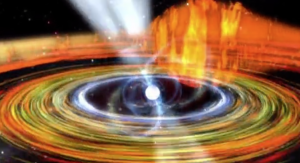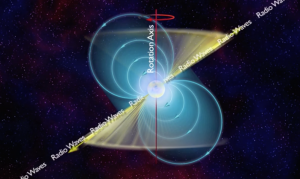In this artist’s animation, the December 27, 2004 blast from SGR 1806-20 was the brightest outburst ever seen coming from an object beyond our own Solar System. Even at 50,000 light-years away, its burst of gamma rays and X-rays disturbed the Earth’s ionosphere, causing a sudden disruption in some radio communications. A magnetar is a superdense neutron star with a magnetic field thousands of trillions of times more intense than that of the Earth. Scientists believe that SGR 1806-20’s giant burst of energy was somehow triggered by a “starquake” in the neutron star’s crust that caused a catastrophic disruption in the magnetar’s magnetic field. The magnetic disruption “boiled off” particles from the star’s surface into a rapidly-expanding fireball.


Scott Ransom: Part 7 General Relativity
Scott Ransom, an astronomer at NRAO, talks about General Relativity and its use in his pulsar research.

Scott Ransom: Part 5 Recent Results
Scott Ransom, an astronomer at NRAO, talks about his most recent research on pulsars.

Scott Ransom: Part 4 Magnetic Fields
Scott Ransom, an astronomer at NRAO, talks about how the spin of neutron stars affects their magnetic fields.

Scott Ransom: Part 3 Millisecond Pulsars
Scott Ransom, an astronomer at NRAO, explains what a millisecond pulsar is.

Scott Ransom: Part 2 What is a Pulsar?
Scott Ransom, an astronomer at NRAO, explains what a pulsar is.





